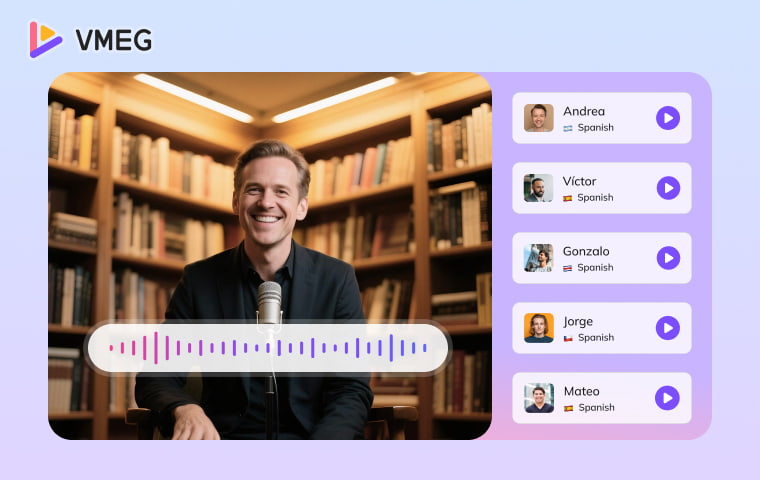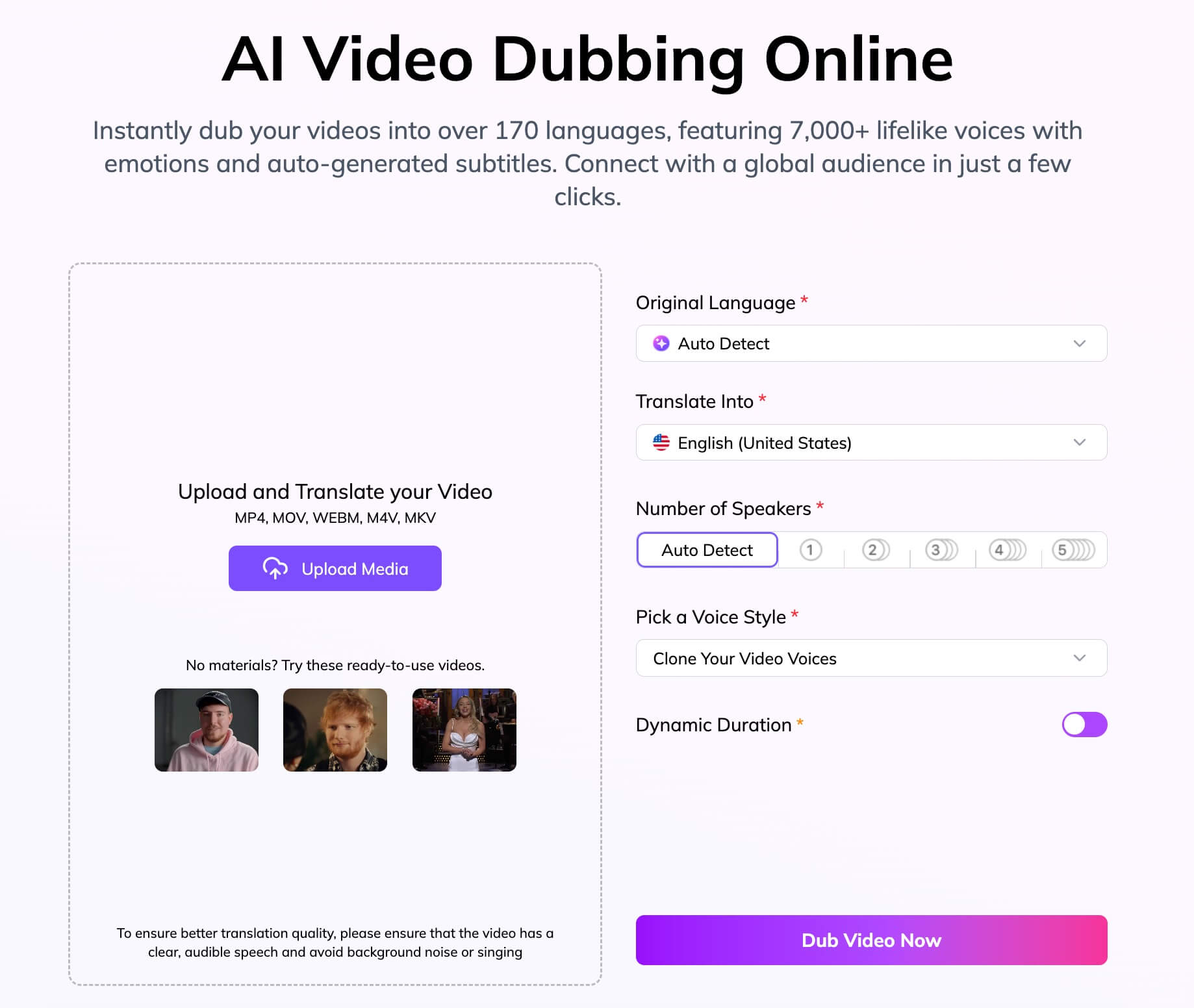
The best part? You don’t need a recording studio or voice actors anymore. With the help of AI dubbing tools, you can now translate, voice, and sync your videos in just a few clicks.
In this guide, we’ll show you exactly how to dub a video using modern AI tools — step by step. You’ll learn how to use features like voice cloning, automatic translation, and lip-syncing to create natural-sounding dubbed content in any language, using platforms like VMEG AI.
What is AI Video Dubbing?

Why Choose AI Video Dubbing?
With video content spreading worldwide, multilingual support has become essential. AI dubbing technology enables you to:
- Quickly localize content for different markets
- Maintain brand voice consistency across languages
- Reduce multilingual content production costs
- Increase content publishing efficiency
2. Technical Advantages
Modern AI dubbing technology offers these core benefits:
- Voice Cloning Technology: Precisely replicates original speaker characteristics
- Emotional Expression: Preserves the original audio's emotional tone and inflection
- Lip Synchronization: Ensures perfect alignment between dubbing and the speaker's mouth movements
Multi-Speaker Recognition: Automatically identifies and processes multiple speakers in videos
3. Wide Application Scenarios
AI video dubbing suits various use cases:
- Education & Training: Multilingual online courses
- Corporate Communications: Product introduction video localization
- Entertainment Content: YouTube videos and podcast dubbing
- News Media: Multilingual news report versions
- E-commerce Marketing: Product demonstration video translation
AI Dubbing VS Traditional Dubbing
Feature | Traditional Dubbing | AI Dubbing with VMEG AI |
|---|---|---|
Cost | High (voice actors, studio time) | Low to moderate (based on video length) |
Speed | Several days to weeks | Minutes to hours |
Scalability | Difficult | Easily dub videos in 100+ languages |
Voice Consistency | Varies per actor | Voice cloning maintains brand/creator tone |
Lip Sync Accuracy | Manual, time-consuming | Automated and AI-enhanced |
How to Dub a Video Using VMEG AI
Following the detailed steps below to dub a video easily:
Step 1. Visit the VMEG AI Dubbing Tool
Go to VMEG AI Dubbing Tool. Drag and drop your video file into the upload area or use the file picker to select it from your device. VMEG will automatically begin analyzing your video and detecting the spoken language.

Once your video has finished uploading and processing, you’ll be prompted to log in or create a free account to continue.

Step 3. Configure Your Dubbing Settings
Select the source language of the video — the system will auto-detect, but manual confirmation ensures accuracy. Then choose one or more target languages from over 170 options.

The dubbing process may take a few minutes, depending on the length and size of your video. Once it is complete, preview the dubbed version. You can adjust the translated text, tweak voice settings such as speed, pitch, and tone, or fine-tune subtitle placement if necessary. When you are satisfied, you can export and download the file in either MP4 or SRT format.
VMEG AI supports over 170 languages and dialects, including 14 variants of English, 22 variants of Spanish, 4 variants of French, 16 variants of Arabic, and 11 variants of Chinese, making it one of the most globally inclusive dubbing platforms available.
2. Extensive Voice Library
VMEG offers over 7,000 natural-sounding AI voices, including male, female, and child options in various age ranges. You can adjust pitch, tone, and emotion to match your content—whether it’s a casual vlog or a formal business video.
3. High-Quality Voice Cloning
VMEG can replicate your original voice in another language, preserving your tone, accent, and speaking style. Ideal for creators and brands who want to maintain a consistent voice across different markets.
4. Realistic Lip Sync
With advanced AI lip-syncing, VMEG aligns translated speech to your mouth movements for a natural and seamless look. Perfect for on-camera content, interviews, and training videos.
5. Smart Multi-Speaker Support
VMEG automatically detects multiple speakers and assigns different voices, even handling background noise and overlapping dialogue. This makes it great for interviews, discussions, or videos with complex sound environments.
VMEG.AI vs. Other AI Dubbing Tools Comparison
Feature | VMEG.AI | HeyGen | Dubverse | Rask.ai | InVideo |
|---|---|---|---|---|---|
Language Support | 170+ | 70+ | 30+ | 130+ | 50+ |
Voice Library Size | 7,000+ voices | Limited (custom clone only) | Medium (100+ voices) | Medium (100+ voices) | Limited (preset TTS) |
Voice Cloning | High-fidelity cloning, Supports all languages | Custom voice (basic) | Cloning via avatar | VoiceClone (30+ langs) | Not supported |
Lip Sync Quality | Cinema-grade | Natural + synced | Basic sync | AI-driven sync | Basic TTS alignment |
Multi-Speaker ID | Automatic | Manual setup | Not available | Multi-speaker detection | Not supported |
Emotion Control | Fine-tuned pitch/emotion | Not customizable | Limited tone control | Not customizable | Not customizable |
User Interface | Clean, browser-based | Polished, pro-grade UI | Simple & guided | Functional, more technical | Easy for beginners |
Pricing | Medium (freemium model) | High (per video/token) | Medium (subscription) | High (usage-based) | Low (basic free use) |
FAQs on AI Dubbing
VMEG.AI uses advanced neural machine translation and speech recognition models to deliver over 99% accuracy in both transcription and dubbing. It handles most content fluently and naturally, and also supports manual proofreading, custom pronunciation, and term adjustments—ensuring high precision even for technical or domain-specific language.
How long does dubbing processing take?
Processing time depends on video length and complexity:
- Videos under 5 minutes: Usually 2-5 minutes to complete
- 10-30 minute videos: 5-15 minutes to complete
- Longer videos: Proportionally increased processing time
- Complex multi-speaker videos may require additional time
What video formats are supported?
VMEG supports common formats like MP4, MOV, WEBM, M4V, and MKV. For best performance, MP4 is recommended.
Can dubbing quality reach professional standards?
VMEG.AI's dubbing quality has reached professional broadcaster standards. Through advanced voice cloning and emotional expression technology, generated dubbing meets commercial use requirements in naturalness, clarity, and emotional expression.
Does it support custom voices?
Yes. Users can upload their own voice samples for training to create exclusive AI voice models. This is crucial for brand consistency and personal characteristic preservation.
Who owns the copyright of dubbed files?
A: Copyright of files generated using VMEG.AI belongs to users. The platform does not retain or use user content, ensuring user intellectual property security.
Conclusion
Whether you're an individual creator or enterprise user, mastering AI dubbing technology will add unlimited possibilities to your content. Through this article's detailed guidance, you now possess all the knowledge and skills needed to use VMEG.AI for professional video dubbing. Start your AI dubbing journey now, let your content reach every corner of the globe, and create greater value and impact.
